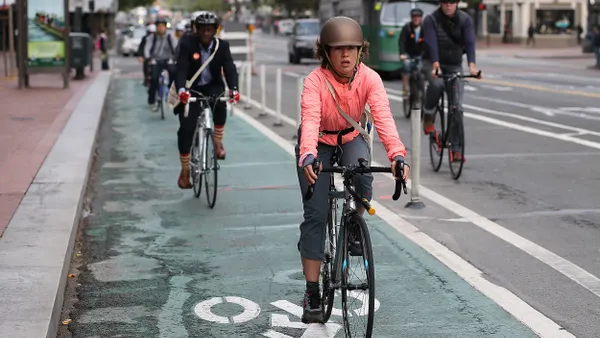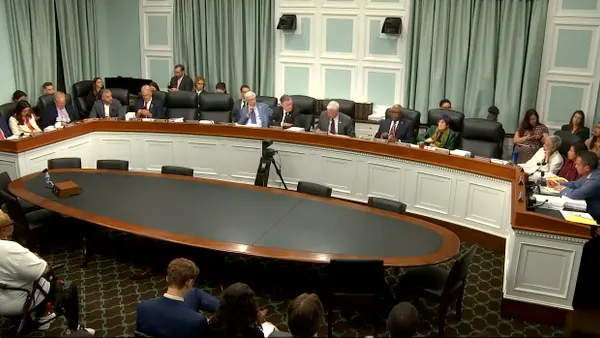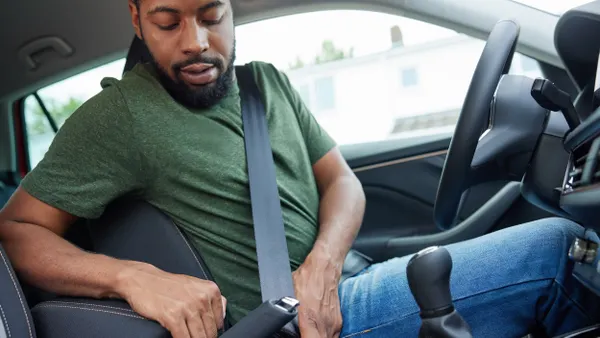Dive Brief:
- Amazon subsidiary Zoox gave a first peek at its autonomous robotaxi on Monday, saying the fully electric vehicle is built for "dense, urban environments," and can reach speeds of up to 75 miles per hour in both directions.
- The robotaxi, which has been in development for the past six years, includes 100 safety innovations that Amazon and Zoox say do not exist in conventional cars. Those innovations include airbags for use whichever way the autonomous vehicle (AV) is traveling; carriage-style seating designed to envelop passengers as they face each other; and sensor technology that combines cameras, radar and LiDAR for a 270-degree field of view.
- Zoox, which was acquired by Amazon earlier this year for an undisclosed amount after months of rumors surrounding its future, is testing its AVs in Las Vegas, San Francisco and other locations in the Bay Area.
Dive Insight:
After several years of development, this unveiling is a significant step for Zoox, which last year promised to launch a robotaxi network in Las Vegas in 2020 but has yet to do so. Company officials did not respond to requests for comment on the status of that program or a possible timeline for its launch.
This news comes just weeks after Uber confirmed the sale of its Advanced Technologies Group (ATG) to Aurora Innovation as the AV industry continues to consolidate and search for profitability.
In a statement, Zoox CEO Aicha Evans said the robotaxi reveal "is an exciting milestone in our company’s history and marks an important step on our journey towards deploying an autonomous ride-hailing service." Evans also pledged the company would build a "sustainable, safe solution" to help people get around.
One of the major stumbling-blocks around AVs has been the need to ensure they are safe and that the technology they use ensures that safety. Tesla CEO Elon Musk has suggested that the use of LiDAR is a "fool's errand," although other experts have said it will need to be part of a suite of tools.
The technology fires rapid pulses of laser light at a surface, then uses a sensor to measure how long it takes for those pulses to bounce back. The differences in the time it takes those pulses to return are used to make digital 3D images, and proponents say its ability to see sometimes hundreds of meters ahead gives AVs ample time to prepare for possible obstacles.
Building-in redundancies is key, some experts have said, to ensure there is no repeat of the fatal pedestrian crash involving an Uber-owned AV in Tempe, AZ in 2018.
"Imagine the cameras that are on your car, it's inevitable that a camera frame is going to get dropped," Jeff Phillips, Global Go-To-Market Leader for Transportation at National Instruments (NI), said. "At some point in the operating model of a car there's going to be interference or something that conflicts with the image, and the car’s going to have to be able to handle that without catastrophic failure."
Robotaxis have been one of the earliest test cases for AVs, in addition to autonomous shuttles and even autonomous trucks. Waymo has been testing its fleet on public roads in Phoenix and returned to the Bay Area earlier this year after suspending operations due to the coronavirus pandemic. But public sentiment around AVs has remained largely skeptical amid lingering concerns.
Consumer education will be key, especially as cars have started to use more advanced technology even with people still behind the wheel, Phillips said. A robotaxi network could be another intriguing use case, and a good way to build that public trust in the technology, especially as companies have sunk millions of dollars into research and development, Phillips said.
"It's too much of a self-fulfilling prophecy, there's too much money in that industry, for our society to not chase it," Phillips said. "[If] you look at the way the industry has done it today, it's been a slow creep."











